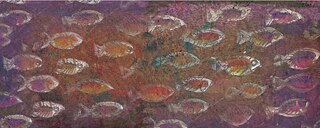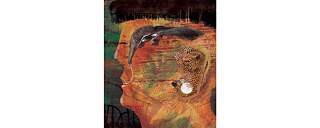Indigenous Cultures
From Visible — and Invisible — Worlds

In indigenous American cultures, dreams establish connections between reality and the invisible worlds, from encounters with ancestors to hunting strategies. They also serve as a guide for future decisions.
By Camila Gonzatto
“The white people do not dream as far as we do. They sleep a lot, but they only dream of themselves,” says David Kopenawa, a Yanomami shaman from Brazil, in the book La caída del cielo (The Falling Sky), written in collaboration with anthropologist Bruce Albert. The indigenous leader’s words point to the differences we can find between dreams, their meaning, interpretation, and importance for indigenous peoples and other cultures.
João Vianna, an anthropologist, psychologist, and professor at the Federal University of Espírito Santo and researcher at GAIA: Núcleo de Estudios de los Pueblos de la Tierra (Center for the Study of Peoples of the Earth), underscores that there is an important characteristic of the Amerindian dream in this observation by Kopenawa: it has to do with a kind of “journey,” where those who are dreaming are able to meet with their ancestors and non-human beings like animals, plants, and spirits. “The indigenous dream is not an interior journey in search of the hidden truth of personal identity, but rather a movement that is ‘outward.’ It is extra-personal, directed toward that which is distant, different, other, with all the risks and powers it implies. That is why the dream is so important to indigenous peoples,” the researcher says.
According to Vianna, there is no “dreamworld” for indigenous cultures. Dreams offer access to other worlds, which are part of the reality in which we live, but which are not accessible in waking hours. “That is how we can understand that hunters dream of their potential prey, in their own worlds; shamans dream of their auxiliary spirits, of the spirits who are the ‘masters’ of disease, of the demiurges that guide them, and, for that, they need to leave the human world. The dream is what we call this exchange of perspectives that can favor the hunter and the shaman or weaken the sick who surrendered to the attacks and/or the spells of the evil spirits,” he explains.
ANCESTRAL CONNECTION
Although there are some similarities, among different indigenous communities, dreams can have different interpretations and meanings. The writer and indigenous activist Edson Krenak says that, according to the Watu people of the Rio Doce Valley, particularly in the village of Vanuíre, dreams are a path — an educational and generational bridge — that connects children to their elders and ancestors.“Because of the historical trauma the Krenak diaspora has suffered — the violence, the crimes against our land and against the Watu (the river) — dreams offer us paths of healing and hope. Without dreams, we are separated from our ancestors, and we are devoid of the possibilities to connect with our ancestors. Dreaming prepares us to be good ancestors today,” says Krenak.
ANTICIPATING THE FUTURE
In this sense, Daniel Munduruku, writer and professor from Pará who belongs to the Munduruku indigenous community, also affirms that dreams are presented as an open window to the tridimensional world that exists beyond that in which we move. “That world is of great importance to daily life, and some people even hold dream-sharing sessions when they wake up. Dreams can determine how hunting or fishing will go; they can anticipate happy or sad events; they can make prophecies about future events.”Krenak signals that, if dreams are indeed used to deal with fears, challenges, and plans for the future, there is nothing premonitory in them like in the Judeo-Greco-Christian view, nor anything linear. “The path of dreams is almost always circular and multilinear. Therefore, past, present, and future are mixed in dreams, stories, and rituals. We are the future. Our ancestors are the future of our generation,” he adds.
For the Baniwa, an Arawak-speaking people who live along the Içana River in Northwest Amazonia, hunters may search in their dreams for places to find their potential prey, says Vianna, who carries out research in the region. “It’s not as much about ‘predicting the future;’ it’s more about obtaining privileged information, anticipating the hunted animals’ movement, and, yes, it is possible to hunt one’s prey while dreaming, allowing the dreamer to wake up and search for its body. In the same way, to cure the sick, shamans need to travel to other worlds in search of their patient’s soul that was captured by a sorcerer who carried him away,” the researcher says.
DREAM SHARING
In many cultures, children and adults are encouraged to share their dreams. “When I was a child and used to visit my aunt in Minas, we would sit around the fire eating cassava cakes and sharing our dreams. She would always connect our dreams to our ancestors’ stories,” Krenak recalls. Among the Munduruku, shamans are the interpreters of dreams that the dreamer does not understand. “Since we were little, we were taught not to let the dreams we dreamed get away, so we would not run the risk of being accused of not listening to the voices of the ancestors who were talking to us through our dreams,” he explains.However, there are cases where the dream should not be shared. “In general terms, an ordinary dreamer, meaning a dreamer who is not a shaman, has to reveal his dream if it is bad, dangerous, what the Baniwa call a ‘bad dream,’ but he must keep it a secret if it is auspicious.” Such is the case, for example, of hunters’ dreams. “Those in which the dreamer understands he has high chances of success hunting must be kept confidential until he succeeds in the task that was initiated by the dream,” says Vianna.
from the DISCUSSION GROUP TO LITERATURE
Stories lived in dreams are present in books, primarily in contemporary indigenous children’s literature. Daniel Munduruku began writing for children when they asked him about the stories that he was telling them orally. He has already published more than 50 books in Brazil and abroad. “Normally, I try to bring the public closer to the reality of the dream, showing them how there are languages that are invisible to us and that allow us to nourish the happiness and mystery within us,” he says.Dreams are also important material in Edson Krenak’s literary production, in both prose and poetry. “I always tell my dreams to my teachers, shamans, elders, and fellow shaman peers. They show me, through the words we share, the fabric of history. Narrative has many collective dimensions. If I keep the dream to myself, the images will be blurry, disconnected, and have no meaning. When shared with the community, the dream is transformed.”
Krenak won the 10th National Tamoios Award for Indigenous Writers in Brazil with his book O Sonho de Borum (Borum’s Dream). The author translates dreams into books because, for him, “dreams are the ontological and utopian possibilities of a balanced life, of humans and other species sharing the same planet and their visible and invisible worlds,” he concludes.



